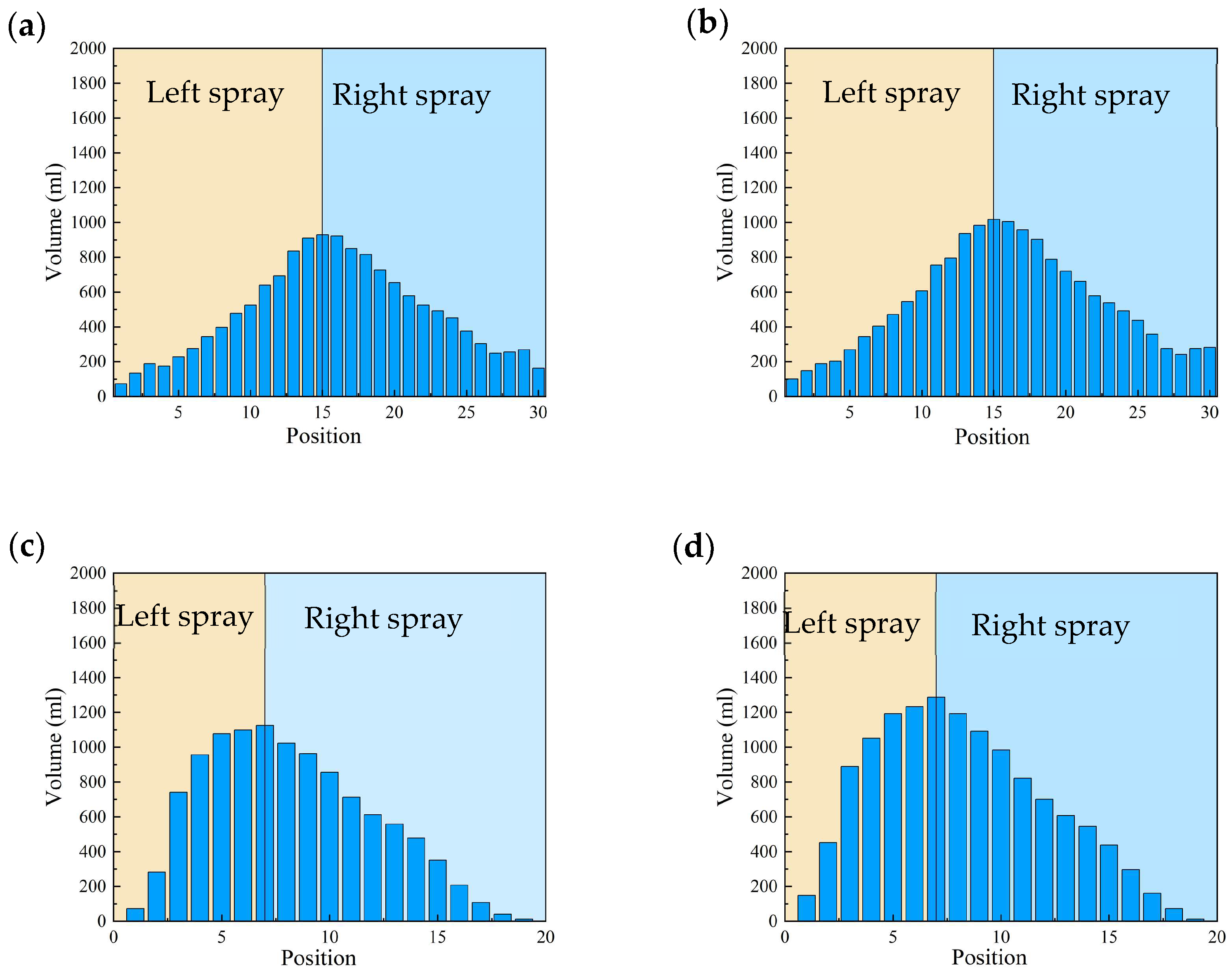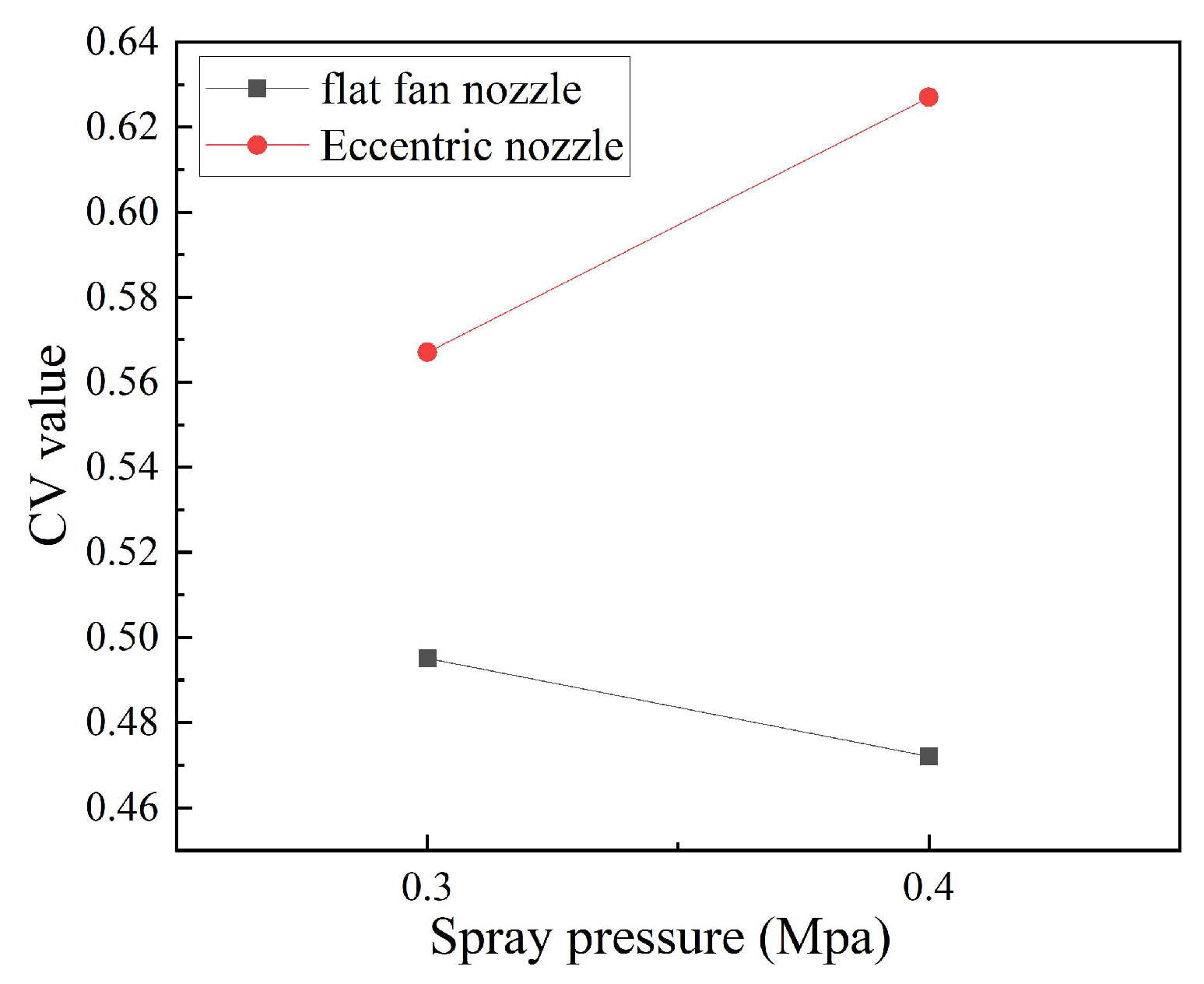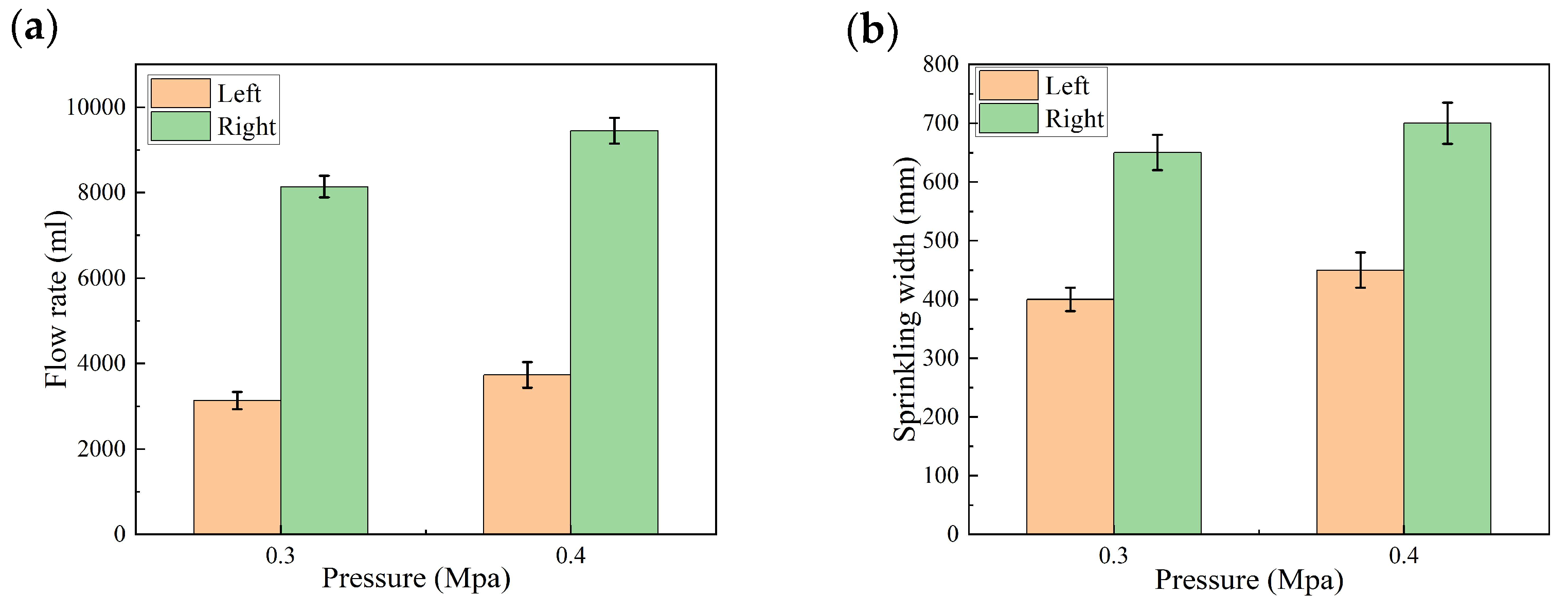Effects of Nozzle Arrangement Strategies on Spray Uniformity in Soybean–Maize Intercropping
Abstract
:1. Introduction
2. Materials and Methods
2.1. Experimental Design
2.2. Single Nozzle Spray Distribution and Spray Angle Determination
2.3. Combination of Eccentric Nozzles and Fan-Shaped Nozzles
3. Results
3.1. Spray Uniformity
3.2. Coefficient of Variation of Spray Distribution
3.3. Spray Deposition Distribution at the Edge of the Spray Band
3.4. Spray Boundary Compactness
4. Discussion
5. Conclusions
- (1)
- First, the spray volume and spray width of eccentric and fan-shaped nozzles were examined. At 0.3 MPa, the spray volume on the right side of the eccentric nozzle was 2.6 times that of the left side, and the spray width was 1.6 times greater. The coefficient of variation (CV) for the eccentric nozzle was 0.57, and the compactness was 0.43. In contrast, the fan-shaped nozzle exhibited a CV of 0.5. At both 0.3 MPa and 0.4 MPa, the spray compactness of the eccentric nozzle was significantly lower than that of the fan-shaped nozzle 18.9% lower at 0.3 MPa and 12.5% lower at 0.4 MPa indicating the eccentric nozzle is more suitable for edge spraying.
- (2)
- Based on the width of the maize rows and plant height, a combination of two eccentric nozzles was selected. The configuration with 70 cm spacing yielded the lowest CV of 0.3, ensuring spray uniformity (investigated for spacing of 50, 70, and 90 cm). The influence of one eccentric nozzle on the flow rate to the left side of the adjacent nozzle was also analyzed, showing a difference of less than 1.5%, indicating that dual eccentric nozzles can achieve both edge compactness and uniform spray coverage.
- (3)
- For the soybean rows, a combination of eccentric and fan-shaped nozzles was selected. Among the three nozzle spacings (50 cm, 70 cm, and 90 cm), a spacing of 90 cm achieved the lowest CV of 0.33, ensuring uniform spray distribution. Additionally, the influence of the fan-shaped nozzle on the left-side flow of the eccentric nozzle was examined, with a flow rate difference within 1.5%, confirming that the combination ensures both internal uniformity and edge compactness within the soybean band.
Author Contributions
Funding
Data Availability Statement
Acknowledgments
Conflicts of Interest
References
- MacLaren, C.; Waswa, W.; Aliyu, K.T.; Claessens, L.; Mead, A.; Schöb, C.; Vanlauwe, B.; Storkey, J. Predicting intercrop competition, facilitation, and productivity from simple functional traits. Field Crops Res. 2023, 297, 108926. [Google Scholar] [CrossRef]
- Antonelli, C.R.; Cabral, E.; Berejnoi, D.E.; Priotto, J.; Gomez, M.D. Plot and border effects on herbicide-resistant weed seed consumption by rodents in corn and soybean crops of central Argentina. Agric. Ecosyst. Environ. 2025, 378, 109320. [Google Scholar] [CrossRef]
- Egli, D.B. Yield improvement and yield components: A comparison of corn and soybean. Crop Sci. 2023, 63, 1019–1029. [Google Scholar] [CrossRef]
- Gannett, M.A.; Butler-Jones, A.L.; DiTommaso, A.; Sparks, J.P.; Kao-Kniffin, J. Soil C: N impacts on soil biological health and consequences on weed control in soybean and corn systems. Weed Sci. 2024, 72, 402–421. [Google Scholar] [CrossRef]
- Shang, Z. Design and Experimental Study on Small Electric Self-Propelled Striping Boom Sprayer. Master’s Thesis, HeNan Agricultural University, Zhengzhou, China, 2021. [Google Scholar] [CrossRef]
- Zhang, S.; Wang, B. Shandong Vikes provides precision plant protection machinery for corn and soybean compound planting. Farm Mach. 2022, 32. [Google Scholar] [CrossRef]
- Chen, R.; Li, H.; Wang, J.; Chen, C. Effects of plate structure and nozzle diameter on hydraulic performance of fixed spray plate sprinklers at low working pressures. Trans. ASABE 2021, 64, 231–242. [Google Scholar] [CrossRef]
- Jiang, Y.; Liu, J.; Li, H.; Hua, L.; Yong, Y. Droplet distribution characteristics of impact sprinklers with circular and noncircular nozzles: Effect of nozzle aspect ratios and equivalent diameters. Biosyst. Eng. 2021, 212, 200–214. [Google Scholar] [CrossRef]
- Issaka, Z.; Li, H.; Jiang, Y.; Tang, P.; Chen, C.; Fordjour, A. Comparative evaluation on performance characteristics of an impact sprinkler with nozzle-dispersion devices and rotary plate sprinkler. Appl. Eng. Agric. 2020, 36, 321–329. [Google Scholar] [CrossRef]
- Wei, Z.; Zhu, H.; Zhang, Z.; Salcedo, R.; Duan, D. Droplet size spectrum, activation pressure, and flow rate discharged from PWM flat-fan nozzles. Trans. ASABE 2021, 64, 313–325. [Google Scholar] [CrossRef]
- Villermaux, E. Fragmentation. Annu. Rev. Fluid Mech. 2007, 39, 419–446. [Google Scholar] [CrossRef]
- Wang, L.; Jiang, M.; Sun, W.; Chen, B. The Type Choice of Nozzle in Sprayer Design. J. Agric. Mech. Res. 2005, 151–153. [Google Scholar] [CrossRef]
- Qin, W.; Xue, X.; Cui, L.; Zhou, Q.; Xu, Z.; Chang, F. Optimization and test for spraying parameters of cotton defoliant sprayer. Int. J. Agric. Biol. Eng. 2016, 9, 63–72. [Google Scholar] [CrossRef]
- Griesang, F.; Spadoni, A.B.D.; Ferreira, P.H.U.; Ferreira, M.d.C. Effect of working pressure and spacing of nozzles on the quality of spraying distribution. Crop Prot. 2022, 151, 105818. [Google Scholar] [CrossRef]
- Nuyttens, D.; Baetens, K.; De Schampheleire, M.; Sonck, B. PDPA laser-based characterization of agricultural Spray nozzles. Agric. Eng. Int. CIGR Ejournal 2006, VIII. Available online: https://ecommons.cornell.edu/server/api/core/bitstreams/51495db3-214a-4c81-9a6d-b2e9d71c7cb6/content (accessed on 1 June 2024).
- Nuyttens, D.; De Schampheleire, M.; Verboven, P.; Brusselman, E.; Dekeyser, D. Droplet size and velocity characteristics of agricultural sprays. Trans. ASABE 2009, 52, 1471–1480. [Google Scholar] [CrossRef]
- Nuyttens, D.; De Schampheleire, M.; Baetens, K.; Brusselman, E.; Dekeyser, D.; Verboven, P. Drift from field crop sprayers using an integrated approach: Results of a five-year study. Trans. ASABE 2011, 54, 403–408. [Google Scholar] [CrossRef]
- Edwards, C.J.; Ripper, W.E. Droplet Size, Rates of Application and the Avoidance of Spray Drift. 1954. Available online: https://www.cabidigitallibrary.org/doi/full/10.5555/19551102521 (accessed on 1 June 2024).
- Mattivi, P.; Pappalardo, S.E.; Nikolić, N.; Mandolesi, L.; Persichetti, A.; De Marchi, M.; Masin, R. Can Commercial Low-Cost Drones and Open-Source GIS Technologies Be Suitable for Semi-Automatic Weed Mapping for Smart Farming? A Case Study in NE Italy. Remote Sens. 2021, 13, 1869. [Google Scholar] [CrossRef]
- Li, Y.; Wu, Y.; Xue, X.; Liu, X.; Xu, Y.; Liu, X. Efficiency-first spraying mission arrangement optimization with multiple UAVs in heterogeneous farmland with varying pesticide requirements. Inf. Process. Agric. 2024, 11, 237–248. [Google Scholar] [CrossRef]
- Gong, C.; Li, D.; Kang, C.; Wang, Y. Visualisation of the evolution of perforations in oil-based emulsion sheets formed by flat-fan spray nozzles. Biosyst. Eng. 2021, 207, 68–80. [Google Scholar] [CrossRef]
- Cao, Y.; Xi, T.; Xu, L.; Qiu, W.; Guo, H.; Lv, X.; Li, C. Computational fluid dynamics simulation experimental verification and analysis of droplets deposition behaviour on vibrating pear leaves. Plant Methods 2022, 18, 80. [Google Scholar] [CrossRef]
- He, L.; Ding, L.; Li, B.; Mu, W.; Li, P.; Liu, F. Optimization strategy to inhibit droplets rebound on pathogen-modified hydrophobic surfaces. ACS Appl. Mater. Interfaces 2021, 13, 38018–38028. [Google Scholar] [CrossRef] [PubMed]
- He, L.; Ding, L.; Zhang, P.; Li, B.; Mu, W.; Liu, F. Impact of the equilibrium relationship between deposition and wettability behavior on the high-efficiency utilization of pesticides. Pest Manag. Sci. 2021, 77, 2485–2493. [Google Scholar] [CrossRef]
- Huang, X.; Wang, W.; Li, Z.; Wang, Q.; Zhu, C.; Chen, L. Design method and experiment of machinery for combined application of seed, fertilizer and herbicide. Int. J. Agric. Biol. Eng. 2019, 12, 63–71. [Google Scholar] [CrossRef]
- Zhang, C.; Zhai, C.; Zhang, M.; Zhang, C.; Zou, W.; Zhao, C. Staggered-phase spray control: A method for eliminating the inhomogeneity of deposition in low-frequency pulse-width modulation (PWM) variable spray. Agriculture 2024, 14, 465. [Google Scholar] [CrossRef]
- Liu, J.; Abbas, I.; Noor, R.S. Development of deep learning-based variable Rate agrochemical spraying system for targeted weeds control in strawberry crop. Agronomy 2021, 11, 1480. [Google Scholar] [CrossRef]
- Dengeru, Y.; Ramasamy, K.; Allimuthu, S.; Balakrishnan, S.; Kumar, A.P.M.; Kannan, B.; Karuppasami, K.M. Study on spray deposition and drift characteristics of UAV agricultural sprayer for application of insecticide in redgram crop (Cajanus cajan L. Millsp.). Agronomy 2022, 12, 3196. [Google Scholar] [CrossRef]
- Gao, Z.-M.; Hu, W.; Dong, X.-Y.; Zhao, X.-Y.; Wang, S.; Chen, J.; Qiu, B.-J. Motion behavior of droplets on curved leaf surfaces driven by airflow. Front. Plant Sci. 2024, 15, 1450831. [Google Scholar] [CrossRef] [PubMed]
- Martin, D.E.; Perine, J.W.; Grant, S.; Abi-Akar, F.; Henry, J.L.; Latheef, M.A. Spray deposition and drift as influenced by wind speed and spray nozzles from a remotely piloted aerial application system. Drones 2025, 9, 66. [Google Scholar] [CrossRef]
- Wang, G.; Liu, M.; Ou, M.; Jia, W.; Jiang, L.; Li, Z.; Dong, X.; Huang, Y.; Zhang, T. Anti-drift performance of a hoods spray system for soybean (Glycine max (L.) Merr.)-maize (Zea mays L.) strip intercropping. Crop Prot. 2024, 181, 106689. [Google Scholar] [CrossRef]
- Wang, A.; Li, W.; Men, X.; Gao, B.; Xu, Y.; Wei, X. Vegetation detection based on spectral information and development of a low-cost vegetation sensor for selective spraying. Pest Manag. Sci. 2022, 78, 2467–2476. [Google Scholar] [CrossRef]
- Hua, L.; Jiang, Y.; Li, H.; Qin, L. Effects of different nozzle orifice shapes on water droplet characteristics for sprinkler irrigation. Horticulturae 2022, 8, 538. [Google Scholar] [CrossRef]
- Jiang, Y.; Issaka, Z.; Li, H.; Tang, P.; Chen, C. Range formula based on angle of dispersion and nozzle configuration from an impact sprinkler. Int. J. Agric. Biol. Eng. 2019, 12, 97–105. [Google Scholar] [CrossRef]













| Experimental Subjects | Experimental Design |
|---|---|
| Nozzle type | Eccentric nozzle and fan-shaped nozzle |
| Nozzle combination | Eccentric nozzle and eccentric nozzle, eccentric nozzle and fan-shaped nozzle |
| Spray pressure | 0.3 MPa and 0.4 MPa |
| Spray height | 50 cm |
| Nozzle spacing | 50 cm, 70 cm, and 90 cm |
| Measurement parameters | Coefficient of variation, deposition distribution, and compactness |
Disclaimer/Publisher’s Note: The statements, opinions and data contained in all publications are solely those of the individual author(s) and contributor(s) and not of MDPI and/or the editor(s). MDPI and/or the editor(s) disclaim responsibility for any injury to people or property resulting from any ideas, methods, instructions or products referred to in the content. |
© 2025 by the authors. Licensee MDPI, Basel, Switzerland. This article is an open access article distributed under the terms and conditions of the Creative Commons Attribution (CC BY) license (https://creativecommons.org/licenses/by/4.0/).
Share and Cite
Zhong, W.; Yang, W.; Li, Y.; Wang, G.; Dong, X.; Ou, M.; Jia, W.; Wang, X. Effects of Nozzle Arrangement Strategies on Spray Uniformity in Soybean–Maize Intercropping. Agronomy 2025, 15, 985. https://doi.org/10.3390/agronomy15040985
Zhong W, Yang W, Li Y, Wang G, Dong X, Ou M, Jia W, Wang X. Effects of Nozzle Arrangement Strategies on Spray Uniformity in Soybean–Maize Intercropping. Agronomy. 2025; 15(4):985. https://doi.org/10.3390/agronomy15040985
Chicago/Turabian StyleZhong, Wei, Wanting Yang, Yalong Li, Guanqun Wang, Xiang Dong, Mingxiong Ou, Weidong Jia, and Xiaowen Wang. 2025. "Effects of Nozzle Arrangement Strategies on Spray Uniformity in Soybean–Maize Intercropping" Agronomy 15, no. 4: 985. https://doi.org/10.3390/agronomy15040985
APA StyleZhong, W., Yang, W., Li, Y., Wang, G., Dong, X., Ou, M., Jia, W., & Wang, X. (2025). Effects of Nozzle Arrangement Strategies on Spray Uniformity in Soybean–Maize Intercropping. Agronomy, 15(4), 985. https://doi.org/10.3390/agronomy15040985






